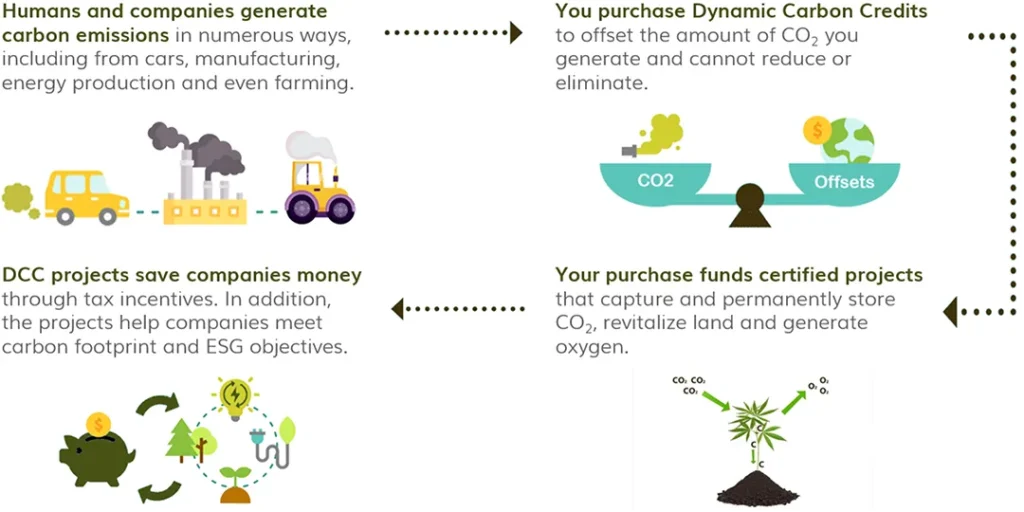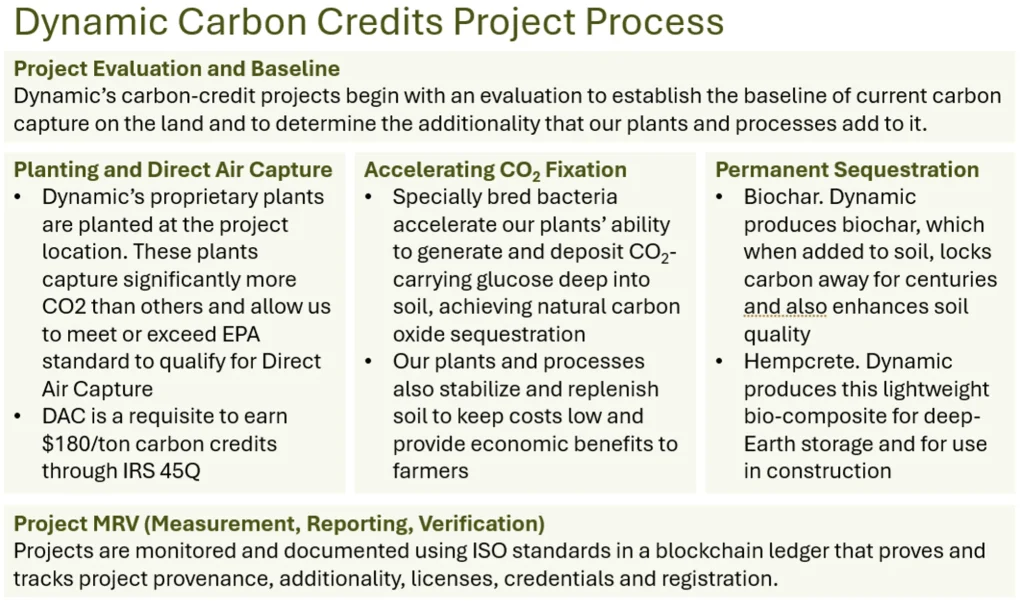At a high level, the idea of carbon credits is simple: a company buys them to offset emissions that they can’t abate themselves. But like most things, the key to creating high-quality carbon credits is in the details.
We created the drawing below to provide a very simple explanation of how people generate excess carbon dioxide, how companies can buy carbon credits, what their purchases deliver, and how companies can save money through tax incentives.

Understanding High-Quality Nature-Based Agricultural Carbon Credits
Nature-based agricultural carbon credits are a way to monetize the carbon sequestration and greenhouse gas (GHG) reduction efforts within agricultural practices. Here’s how it works: through sustainable and regenerative techniques, farmers can capture carbon dioxide (CO₂) from the atmosphere and store it in soil and biomass. These efforts can generate carbon credits, which can then be sold on carbon markets or directly to companies looking to offset their carbon footprints.
In addition to helping companies offset their carbon footprints, these credits offer a way for farmers to contribute to environmental stewardship and benefit financially.
Benefits of Nature-Based Projects and Carbon Credits
I believe that nature-based projects, and specifically Dynamic Carbon Credit’s agricultural solutions play an essential role in creating high-quality carbon credits and combating climate change.
The ecosystem created by Dynamic’s solution captures CO2 from the air and sequesters it in its plants, soils and sediments. At the same time, Dynamic’s projects restore the soil on which the plants are grown.
There are four primary reasons why I focus on nature-based, agricultural solutions:
- Speed. The climate crisis must be addressed immediately; and nature-based, agricultural approaches provide a fast and effective way to mitigate greenhouse gas emissions.
- Affordability. Dynamic’s projects are orders of magnitude less expensive than engineered approaches to reduce greenhouse gas emissions. Engineered approaches are slow to bring to market and are economically out of reach for many organizations. On the other hand, nature-based solutions are affordable and quick and easier to implement.
- Sustainability. The essence of nature-based projects not only capture and sequester harmful greenhouse gases, but they also restore and revitalize land and promote biodiversity and economic vitality – all of which support the United Nations’ Sustainable Development Goals.
- Economic opportunity. Farmers can create an additional revenue stream when they work with us and the financial incentive makes it more attractive for farmers to adopt and sustain sustainable practices.
Our Agricultural Projects Behind the Credits
We have developed, refined and continually improved the projects behind our credits, but the core of what we do hasn’t changed.
Proprietary plants and bacteria
We develop unique, proprietary plants that capture and store significantly more carbon dioxide than others. When we plant, we also apply a specific bacterium to promote growth.
No-till farming
Tilling the soil releases carbon dioxide, and therefore, we eliminate or significantly reduce tilling. This helps to preserve soil structure and organic matter, which leads to increase carbon sequestration.
Cover cropping
Our projects are generally applied as cover crops during off seasons. This, along with our other processes, helps to prevent soil erosion, improve water retention and in general, helps to protect and enrich soil, which enhances its ability to sequester carbon.
Biochar application
After harvesting our proprietary plant crops, we make our own biochar and add it back into the soil. Biochar is itself a carbon sequestration technology and acts as a type of fertilizer to enhance soil quality, lower the need for harmful chemical fertilizers, increases water retention and improves porosity.
Combined, these methods and their benefits are a form of regenerative agriculture, a management philosophy that we practice and one that improves soil health.
Our Carbon Credits Qualify for U.S. Federal Incentives
Since our plants capture carbon directly from the atmosphere, our projects and resulting carbon credits quality as Direct Air Capture (DAC). This is important because in the U.S., the federal government provides incentives on DAC of CO2.
The Inflation Reduction Act of 2022 created a national green bank that provides tax deductions and incentives for companies to reduce their carbon footprints and fight climate change.
Dynamic’s nature-based projects meet or exceed EPA guidelines for direct air capture and sequestration of greenhouse gasses, which makes them eligible for the $180/ton incentive to carbon credit transferees under Section 45Q of the IRS code.
How We Generate, Measure, Report and Verify Our Carbon Credits
To transform our projects into carbon credits, the carbon sequestration or GHG reduction must be quantified and certified by a reputable standard. Our projects can be found in the Climate Action Reserve registry, one of the oldest, most trusted in the global carbon markets. Here’s our process:

Retiring Carbon Credits
Retiring a carbon credit means that the credit is taken out of circulation permanently. This process ensures that the credit cannot be used again to offset another emission. Retiring credits is critical to maintain the integrity and transparency of the carbon credits market. It provides a verifiable way to track that a certain amount of CO₂ has been removed from the atmosphere.
The Process of Retiring Carbon Credits
- Purchase of Carbon Credits:
- When a company or individual purchases carbon credits, they are buying the right to claim the environmental benefit of a specific amount of CO₂ being removed or avoided. These credits are often purchased through carbon markets or directly from project developers like Dynamic Carbon Credits.
- Ownership Transfer:
- Upon purchase, the ownership of the carbon credits is transferred to the buyer. This is documented and tracked within a carbon registry, which is an online database that ensures transparency and accountability.
- Declaration of Intent to Retire:
- The buyer then declares their intention to retire the carbon credits. This is typically done through the carbon registry where the credits are held. The registry will require the buyer to specify details such as the number of credits to be retired and the reason for retirement, such as offsetting corporate emissions.
- Registry Update:
- The carbon registry updates its records to reflect the retirement. This involves marking the credits as “retired” in the database, ensuring they cannot be sold or transferred again. The registry typically issues a retirement certificate to the buyer as proof that the credits have been retired.
- Public Record:
- Most carbon registries maintain a publicly accessible record of retired credits. This transparency allows third parties to verify that the credits have indeed been retired and are no longer in circulation. This public record includes details such as the project from which the credits originated, the quantity of credits retired, and the date of retirement.
Why Retirement Matters
Retiring carbon credits is crucial for several reasons:
- Ensures Authenticity:
- Retirement guarantees that the carbon offset claimed by the buyer is genuine and that the corresponding emissions reductions are real. This prevents double-counting and ensures that each credit represents a unique reduction or removal of CO₂.
- Maintains Market Integrity:
- The carbon credits market relies on trust and transparency. By retiring credits, the market ensures that credits are not reused, thereby maintaining the integrity and credibility of the system.
- Achieves Climate Goals:
- The goal of carbon credits is to mitigate climate change. Retirement ensures that the environmental benefits of the credits are realized, contributing to overall emissions reductions and helping to achieve global climate goals.
My Commitment to Sustainable Agriculture
As someone deeply invested in this industry, I’m committed to promoting and advancing agricultural nature-based carbon credits. They represent a practical and impactful way to address the climate crisis that benefits the environment and the agricultural community.
Our challenge is to continue to refine practices related to nature-based, agricultural carbon credits in order to unlock their full potential and allow these projects to help in our collective fight against climate change.
